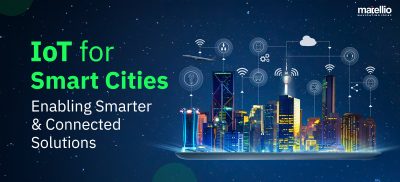
The need to be connected at all times is now greater than ever before. To accommodate the fast pace of a modern-working man all our devices need to be within our reach at all times. We live our lives by strict timetables, and we cannot afford to upset them; it is the prime reason why the Internet of Things (IoT) technology came to be. The idea of IoT emerged some ten years ago and ever since then, its popularity has skyrocketed.
In 2009, the global IoT market was worth 182.2 billion U.S. dollars and in 2018, it’s worth 1391 U.S. dollars. And if you think that the IoT bubble is about to burst, then think again. Because according to Statista.com, the global IoT market is projected to be worth 1710.4 billion U.S. dollars in 2019!
From being able to turn On your coffee maker while you’re still in your car, to be able to contact sensors in your factory, IoT has enabled us in countless ways. Furthermore, with the rise of smartphone apps, the need and popularity of IoT have only increased. Smart homes, wearable apps, connected cars are just some of many types of apps employing IoT technology.
But customers are not the only ones using this technology. To meet customers’ ever-increasing needs, enterprises are using IoT tech now more than ever. IoT helps enterprises to focus their efforts, tweak their products and services in ways which will be most profitable for them. Furthermore, using IoT, enterprises are developing better and better products which in return simplify their customers’ lives.
How is IoT being used by Enterprises?
1. Manage real-time data
By gathering real-time data, enterprises can keep a strict watch over their product inventory, assets, and day-to-day operation of the business. This data allows enterprises to monitor supply chain in real-time, detect a security breach and monitor remote-assets. All of this combines to generate a better and self-running business model and increases an enterprise’s efficiency.
2. Automate work Management
In the past few years, there has been a steep rise in the automation sector. Many companies, to decrease their labor cost and scope for manufacturing errors, have opted to make their businesses completely automated. While automation is a wonderful thing for a business to have on its own, when fused with IoT, its advantages increase many times. By using IoT and AI, we can predict system failures in machines and can have them fixed before they even occur. Furthermore, using IoT analytics, we can create a centralized repository of this data to decrease the probability of an industrial disaster happening and save many lives.
3. Disaster Management
By using sensors and warning devices, we can implement a strict security plan in an enterprise. In companies, especially dealing with hazardous chemicals and gases, a faulty warning system can mean the loss of lives. To prevent that from happening sensors are placed in various places which keep a stern gaze over multiple constraints you put in. For example, a possible gas leak could be detected using a sensor which is a part of an IoT. The moment the pressure in the tank goes below a certain mark, it alerts system admins, and they take required actions, thus saving lives of workers and people living near the factory.
Also Read: IoT Consulting Services: Everything You Need to Know
What are the issues faced while Implementing IoT?
While there is no doubt that IoT has changed the way businesses run irreversibly, and for the better too, implementing it is a challenge which needs to be carried out very delicately. Many new startups are unable to understand how they need to approach IoT development and fail in their very first year. And because it is such a vast spectrum, there is also a severe lack of expertise in the IoT market as well.
Given below is a list of the five most significant issues faced during IoT development and how the industry leaders are addressing them.
1. Security
To paraphrase Peter Parker, with great technology, comes terrible threats. Since the internet is the backbone of IoT technology, it is vulnerable to all the dangers a typical internet system faces. The biggest concern at times when everything is connected is that of the security of users’ crucial data. Cybercrimes are very easy to conduct these days, and the extent of the damage they can cause has increased as well since all the devices are connected now; an ordinary hack can lead to the collapse of an entire system. It is not very uncommon for enterprises to overlook this concern in the race to roll out the newest and most innovative apps. This overlook has lead to some catastrophic cyber attacks in the pase. Mirai botnet attack in 2016 which targeted the DNS provider DYN with a DDOS attack is just one such example.
What to do?
Blockchain technology is one of the most popular technologies in the market right now, and people are finding newer and better ways to make use of it. One such application of blockchain technology is to make IoT device communication secure. A new startup called Krypc uses blockchain technology to make the interaction between various devices in an IoT secure and impervious to any kind cyberattack.
2. Connectivity
The very essence of IoT technology lies in connectivity. Multiple devices are connected over a network, sharing information and working as one cyber-being. So naturally, if there is a problem in connectivity which prevents a seamless sharing of data between these devices, then all the reasons for IoT to exist are lost. Slow internet connection can be one of the problems here. This goes on to hinder the collection of real-time data which is extremely crucial in some places. Nuclear plants and oil rigs are only two of many sites which require rock-solid connectivity between all the IoT devices, because there, not only money but human lives are at stake.
Furthermore, keeping a centralized server in an IoT is also a poor choice. If in some instance, there is a fault then all the devices will lose connection with the server and real-time data will be futile.
What to Do?
The thing to remember with IoT is that the transmission of data is in the form of small packets from sensors to the servers and vice versa. Companies like LoRaWAN and Sigfox develop wireless networks specifically for low-power devices like sensors, electricity meters, smart-watches, etc.
3. Hardware and Compatibility Issues
To implement an IoT capable of working seamlessly, quality hardware is a necessity. Sensors, chips, gateways and boards, they all come together to form a full-fledged IoT network. Now issues generate when the devices used, apart from being of poor quality, have been made by different manufacturers. This leads to compatibility issues between various devices used and can hinder or even stop a network from working the way it should.
Because of different firmware and non-standard M2M (Machine to Machine ) protocol used by various manufacturers, devices face compatibility problems with each other, which is an even greater concern in large-scale IoT implementations.
What to do?
Hurify is a site which, using the token system, provides a worldwide marketplace for buyers from anywhere on the planet to purchase hardware for their IoT establishments. The marketplace offers buyers with a good amount of choice and knowledge about the devices, which can help them in picking the equipment that will be most compatible with their existing systems.
4. Lack of Proper Skills
Another problem which IoT spectrum faces is the lack of experts and trained people. Being such a broad domain, it is impossible for a single person to be able to establish an IoT on his own; from hardware to software, there are many sectors which will require extensive work before an IoT is ready to be used. But there aren’t enough people in the market who can implement what users want from their IoT. This shortage of skilled workforce hits enterprises the hardest because they can never find enough people who can look after and maintain their IoTs.
What to Do?
The instant solution will be to educate the workforce that you have; try turning people you already have into experts. The long-term solution will be to add IoT in college courses so that students can learn about it as a part of their curriculum.
5. IoT analytics
IoT analytics, combined with a powerful AI, can change the face of your business. The most crucial reason why any data is collected is so that it can be used later on to implement some action which in return will improve the current business model or a product. With IoT, we are able to receive real-time data; this means we are able to maintain a bank of the latest data of our product. But collecting data is only one half of the picture; for it to be useful, data needs to be filtered and chopped down into smaller, concise portions which can paint a clear way forward for an enterprise. Establishing an IoT which is capable of storing real-time data and providing analytics, is the aim which most enterprises fail to achieve.
What to Do?
Fixing the problems mentioned above will directly impact analytics for an enterprise. Furthermore, having a strong AI will help you greatly in traversing through a plethora of data and mine out packets of information which are relevant to your current situation.
How much does IoT App Development Cost?
 Now that we have established that IoT implementation is essential for enterprises these days, the next question that arises is how much does IoT development cost? The first thing that you need to understand is that the cost to develop an IoT is directly proportional to its complexity. Furthermore, the size of the implementation will also affect your cost as well. The complexity of an IoT implementation is a variable which depends mostly on the type of system you want to establish. For example, if you want to create an IoT Smart Parking app or a tool for athletes to measure and monitor their fitness metrics- devices like smartwatches and such, then you need to implement an infrastructure of different complexity.
Now that we have established that IoT implementation is essential for enterprises these days, the next question that arises is how much does IoT development cost? The first thing that you need to understand is that the cost to develop an IoT is directly proportional to its complexity. Furthermore, the size of the implementation will also affect your cost as well. The complexity of an IoT implementation is a variable which depends mostly on the type of system you want to establish. For example, if you want to create an IoT Smart Parking app or a tool for athletes to measure and monitor their fitness metrics- devices like smartwatches and such, then you need to implement an infrastructure of different complexity.
After complexity and size, the third thing which will affect your cost is the choice of hardware- sensors, chips, boards that will need to be put in place for your IoT to work properly. If the hardware in your IoT is suboptimal, then connectivity and compatibility issues will arise which in return will obstruct the real-time storage of data, thus nullifying the entire essence of IoT. So you need to choose the right hardware for your IoT.
And in the end, the fourth variable which will affect the cost of your IoT is the development firm you approach. As we have said earlier as well, the IoT industry lacks adequately trained experts who can cater to your every need. Amateurs and poorly-trained engineers can doom your IoT. So choosing the right firm which understands your needs accurately and is capable of catering to them is essential. These firms form their quotes based on two parameters- the complexity of the project, and their per hour rate. We will suggest that, even though it will cost you a bit more, you hire a high-end firm with a skilled workforce and the latest tools to make things happen for you.
What are the regulations to establish an IoT?
Because of its widespread popularity, it was only a matter of time before people started to abuse IoT and use it to commit cybercrimes. Data theft, hacking, identity theft are only among some of many cyber crimes that have been conducted with the help of an insecure IoT. This forced the governments across the globe to form assemblies whose sole purpose is to create regulations and security measures for IoT implementations.
Some of the key regulations revolve around making data sharing between the user and provider, safer. These regulations force the provider to tell the user how exactly their data will be directed, thus ensuring that there is no gap in information. Furthermore, information sharing about cookies, data storage and confidentiality agreements is mandatory to be shared by the providers according to these regulations. Even though most of these rules are there to make sure that the personal data security remains intact, there are other sectors such as Industry Internet of Things, which don’t use users’ personal data but are required to follow these rules nonetheless.
What are the tools for IoT App Development?
There are a couple of good tools in the market to establish an IoT, let us take a look at a couple of them.
1. Arduino (IDE)
Arduino is an Italy based IT company which is a reputed manufacturer of microcontrollers, boards, interactive objects and kits. And its IDE is among the most popular IDEs in the IoT app development game. It offers a complete IoT package containing numerous examples and libraries which support enterprise level IoT establishment. Arduino IDE lets you code microcontrollers in languages like C and C++.
2. Raspbian
Raspbian IDE is one of the best IDEs if you want to achieve your IoT goals using Raspberry Pi board. It has more than 35,000 packages and allows quick installation by using pre-compiled software.
3. DeviceHive
DeviceHive is an open source Machine to Machine (M2M) communication framework. It has a cloud-based API which you can control remotely, away from the network configuration. It is one of the most popular frameworks to build apps for security, smart homes, sensors and automation implementation.
Conclusion
In the past decade of its existence, the Internet of Things has changed the world in many ways. It has allowed the user to achieve many goals which were just not possible before; it has extended our reach, bringing remote devices closer to us and thus taking connectivity to an entirely new level. Thanks to IoT, we live in an era of smart places and devices. Enterprises have benefited from IoT greatly as well; it has morphed the way we do business.
Looking at the past, at the way IoT has enabled us, it is not very hard to predict that in coming years it is only going to become more relevant. Many new sophistications are to come and there are still many areas of our lives which are eagerly waiting to be simplified by the help of IoT technology. Thus, it might be a vast understatement to say that IoT is going to act as the bedrock on which we build our future.



